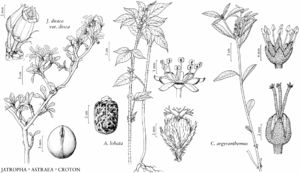Jatropha dioica var. dioica
Plants to 1 m. Leaves: blade oblanceolate to narrowly obovate, 3.5–5 (–7) × 0.3–0.7 cm, usually unlobed, sometimes deeply 3-lobed (in moister sites); secondary-veins visible. Flowers: sepals distinct; petals pinkish white; stamen filaments connate 3/4+ length.
Phenology: Flowering and fruiting late spring–early summer.
Habitat: Dry sandy or rocky soils.
Elevation: 400-–2500 m.
Distribution
Tex., Mexico (Chihuahua), Mexico (Coahuila), Mexico (Durango), Mexico (Nuevo León), Mexico (San Luis Potosí), Mexico (Tamaulipas), Mexico (Zacatecas)
Discussion
Variety dioica is widespread in eastern Mexico south to Zacatecas. R. McVaugh (1945b) reported the range as south to Oaxaca but most of the specimens annotated by him and others as this taxon are currently recognized as two related but morphologically distinct species (Jatropha elbae J. Jiménez Ramírez, and J. oaxacana J. Jiménez Ramírez & R. Torres). In Texas, it is found mainly south and east of the Pecos River.
Selected References
None.
Lower Taxa
"connate" is not a number."connate" is not a number. "distinct" is not a number.
